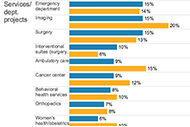Jess Roberts recently left his position as design strategist at Allina Health to launch the Culture of Health by Design at the University of Minnesota. In his new role, Roberts supports health systems as they implement design competency. He discusses the increasingly popular concept of design thinking, an approach described by the company Ideo as putting people at the center of design. Design thinking is gaining converts in health care after working well at places like Procter & Gamble. Roberts shares his vision on the elusive yet intriguing concept, and identifies some common mistakes health care makes in innovation.
Please describe “design thinking” to those who are unfamiliar with the concept.
One of the greatest threats to solving complex 21st-century problems in health care is not a lack of vision, passion or resources, but a chronic lack of creativity. By creativity, I mean the ability to understand problems and their solutions differently. At its core, design thinking is about building a creative competency into an organization's day-to-day operations, strategy and, ultimately, culture. [Roberts also calls it an agile, future-oriented, problem-solving framework well-suited to address complex, dynamic and ill-defined challenges.]
So, design thinking doesn't necessarily have an end goal of unveiling a new clinic or service line.
The notion that this design must come up with a thing at the end of the engagement is outdated. Leaders are designing every day.
What is the role of design thinking in health care?
Design is uniquely suited to problems that are not well-defined or have not been sufficiently addressed. Design is not another form of quality improvement. It is an upstream complement along an innovation and change continuum. Design helps us to avoid doing what we do so well in health care: elegantly solve the wrong problems. Making existing systems that do not work well become more efficient distracts us from the real problems.
You identify three key mindsets for design thinking: developing empathy, radical collaboration and rapid prototyping. How can organizations adopt these?
Unfortunately, health care is tool-obsessed. There’s this fallacy that if you follow a 10-step process, you will come to the right answer. This can distract us by focusing too much on tools and not enough on the problem. At its core, if you are able to practice in the areas of empathy, radical collaboration and rapid prototyping, and not necessarily in sequence or at different times, you will get significantly further than trying to adapt tools that were designed for other systems or industries. If an organization develops empathy, the rest of the framework will be considerably easier.
Isn't health care, by its very nature, already empathetic?
Empathy is not in short supply in health care, true, but it's usually empathy with someone in a typical experience, like a clinical experience. For empathetic engagement to happen, you must get out of your comfort zone, your daily routine and your usual workplace. Allina Health's ‘voice initiative’ gets leadership out into communities to have conversations with community members from a variety of cultural backgrounds and ranging in age from their 20s to late 80s. Some of these participants are patients of Allina but most are not, or would not see themselves as health care consumers. In health care, we typically only engage our superusers, not recognizing that we have the most to learn from those who do not engage us or who choose alternative resources. Direct interaction with people having conversations about what matters most to them prompts the most valuable insights.
How is rapid prototyping different from piloting an idea?
The key to the design-thinking framework is an incredibly agile and rapid approach geared toward learning our way forward into what is often an unknown. Agile and rapid learning may take the form of one conversation or one prototype involving two to five people. Today, health systems can spend 12 months and a lot of human and financial capital to come up with a pilot only to find six months down the road that it doesn't work. Rapid prototyping also can be a much safer and cheaper way to test new ideas.
You and others have said that brainstorming restricts creativity because participants fall into 'group think.' What is the alternative?
The biggest flaw of brainstorming is that it is almost universally an approach to come up with ideas, and ideas are cheap. We see this all the time. The same people get together to address the same problems using the same approach and somehow expect a different outcome. Einstein had a term for just such an activity. Coming up with great ideas to the wrong problems are simply bad ideas in disguise. If you look at history’s great breakthroughs, they were the result of people thinking differently about the problem, not the solution. The ripest opportunity for new ideas is to start from a different problem or a reframed problem. This is one of the most critical elements of the design process, also known as problem-seeking and problem-framing. This is critical because what we think we know about a problem through abstract data sets may be very different from the lived experiences.
What's an example of a design idea that sounded good, but turned out not to be the right problem or solution?
The check-in processes at clinics can be very inhumane. The patient is greeted with legal signs that read something like, “Stand back and don't approach for privacy." Then when it's the patient's turn to check in, he or she is interrogated for information. After that, he or she waits on one side of the waiting room or another. We thought this was a problem that design could solve. So we prototyped a door greeter at a clinic who took down information in a more personal way and led patients back to the exam room. We tested this with five patients. Not one patient commented on it, either positively or negatively. We prompted them to discuss the differences between this approach and a typical interaction. But the change didn't matter to them. We assumed it would be better to have a concierge greeting, but it didn't hit at the real issues facing patients like transportation, child care or stress at home. So we learned, through rapid prototyping with just five people, that this change would not have a significant positive impact. Making experiences less bad is not the same as creating good experiences.
Describe ways to build design-thinking capacity within an organization?
Look for problems that matter to patients and their families, and then organize around the problem and engage people to work on these problems — from the C-suite to the bedside to the call center to the front desk. This is the way you begin to embed design within an organization. You start with the ripe environments that already exist.
How do you quantify success of design thinking?
This is a difficult one because when you start talking about culture change, it's not easy to measure nor does it have a clear return on investment. Success, from my perspective, is how integrated design becomes, through research projects, disparity initiatives, strategic planning, leadership training and on and on. When leaders from around the organization start recognizing the value-add, that, to me, is success.






